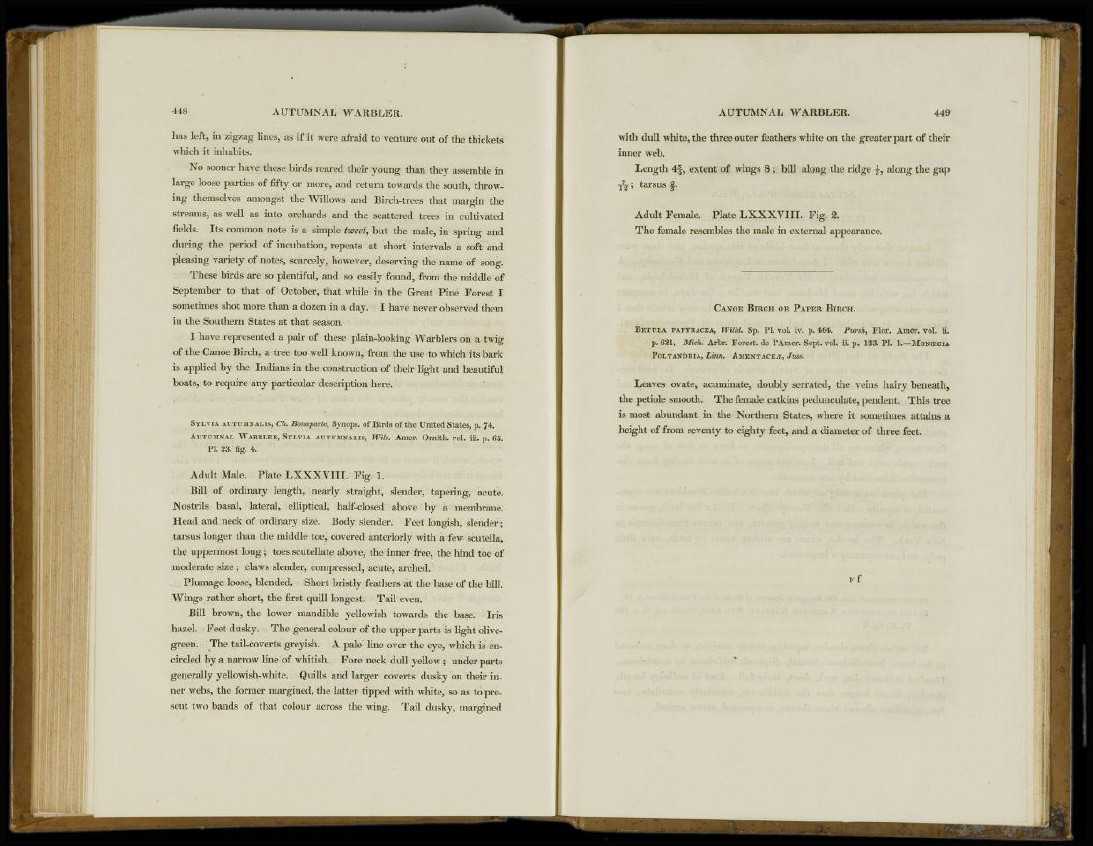
448 AUTUMNAL WARBLER.
has left, in zigzag lines, as if it were afraid to venture out of the thickets
which it inhabits.
No sooner have these birds reared their young than they assemble in
large loose parties of fifty or more, and return towards the south, throwing
themselves amongst the Willows and Birch-trees that margin the
streams, as well as into orchards and the scattered trees in cultivated
fields. Its common note is a simple tweet, but the male, in spring and
during the period of incubation, repeats at short intervals a soft and
pleasing variety of notes, scarcely, however, deserving the name of song.
These birds are so plentiful, and so easily found, from the middle of
September to that of October, that while in the Great Pine Forest I
sometimes shot more than a dozen in a day. I have never observed them
in the Southern States at that season.
I have represented a pair of these plain-looking Warblers on a twig
of the Canoe Birch, a tree too well known, from the use to which its bark
is applied by the Indians in the construction of their light and beautiful
boats, to require any particular description here.
SYLVIA AUTUMNALIS, Ch. Bonaparte, Synops. of Birds of the United States, p. 7 4 .
AUTUMNAL WARBLER, SYLVIA AUTUMNALIS, Wils. Amer. Ornith. vol. Hi. p. 6 5 .
PL 23. fig. 4-.
Adult Male. Plate LXXXVIII. Fig. 1.
Bill of ordinary length, nearly straight, slender, tapering, acute.
Nostrils basal, lateral, elliptical, half-closed above by a membrane.
Head and neck of ordinary size. Body slender. Feet longish, slender;
tarsus longer than the middle toe, covered anteriorly with a few scutella,
the uppermost long; toes scutellate above, the inner free, the hind toe of
moderate size; claws slender, compressed, acute, arched.
Plumage loose, blended. Short bristly feathers at the base of the bill.
Wings rather short, the first quill longest. Tail even.
Bill brown, the lower mandible yellowish towards the base. Iris
hazel. Feet dusky. The general colour of the upper parts is light olivegreen.
The tail-coverts greyish. A pale line over the eye, which is encircled
by a narrow line of whitish. Fore neck dull yellow; under parts
generally yellowish-white. Quills and larger coverts dusky on their inner
webs, the former margined, the latter tipped with white, so as to present
two bands of that colour across the wing. Tail dusky, margined
AUTUMNAL WARBLER. 449
with dull white, the three outer feathers white on the greater part of their
inner web.
Length 4f, extent of wings 8 ; bill along the ridge along the gap
•j7^; tarsus -|.
Adult Female. Plate LXXXVIII. Fig. 2.
The female resembles the male in external appearance.
CANOE BIRCH OR PAPER BIRCH.
BETULA PAPYRACEA, Willd. Sp. PL vol. iv. p. 4 6 4 . Pursh, Flor. Amer. vol. ii.
p. 621, Mich. Arbr. Forest, de l'Amer. Sept. vol. ii. p. 133. Pl. I.—MONOECIA
POLYANDRIA, Linn. A ME NT ACE JE, JUSS.
Leaves ovate, acuminate, doubly serrated, the veins hairy beneath,
the petiole smooth. The female catkins pedunculate, pendent. This tree
is most abundant in the Northern States, where it sometimes attains a
height of from seventy to eighty feet, and a diameter of three feet.
Ff